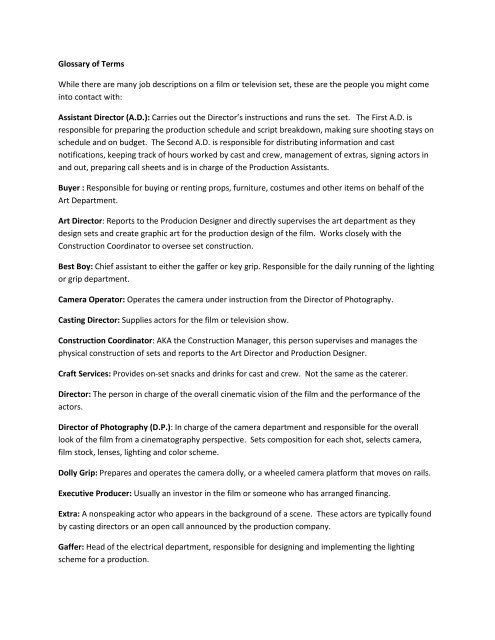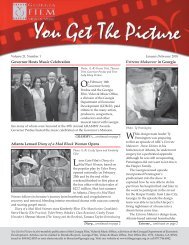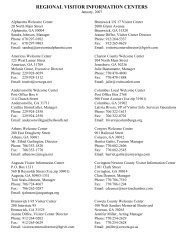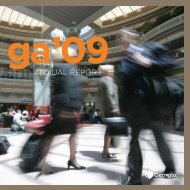Glossary of Film Terms
Glossary of Film Terms
Glossary of Film Terms
Create successful ePaper yourself
Turn your PDF publications into a flip-book with our unique Google optimized e-Paper software.
<strong>Glossary</strong> <strong>of</strong> <strong>Terms</strong><br />
While there are many job descriptions on a film or television set, these are the people you might come<br />
into contact with:<br />
Assistant Director (A.D.): Carries out the Director’s instructions and runs the set. The First A.D. is<br />
responsible for preparing the production schedule and script breakdown, making sure shooting stays on<br />
schedule and on budget. The Second A.D. is responsible for distributing information and cast<br />
notifications, keeping track <strong>of</strong> hours worked by cast and crew, management <strong>of</strong> extras, signing actors in<br />
and out, preparing call sheets and is in charge <strong>of</strong> the Production Assistants.<br />
Buyer : Responsible for buying or renting props, furniture, costumes and other items on behalf <strong>of</strong> the<br />
Art Department.<br />
Art Director: Reports to the Producion Designer and directly supervises the art department as they<br />
design sets and create graphic art for the production design <strong>of</strong> the film. Works closely with the<br />
Construction Coordinator to oversee set construction.<br />
Best Boy: Chief assistant to either the gaffer or key grip. Responsible for the daily running <strong>of</strong> the lighting<br />
or grip department.<br />
Camera Operator: Operates the camera under instruction from the Director <strong>of</strong> Photography.<br />
Casting Director: Supplies actors for the film or television show.<br />
Construction Coordinator: AKA the Construction Manager, this person supervises and manages the<br />
physical construction <strong>of</strong> sets and reports to the Art Director and Production Designer.<br />
Craft Services: Provides on-set snacks and drinks for cast and crew. Not the same as the caterer.<br />
Director: The person in charge <strong>of</strong> the overall cinematic vision <strong>of</strong> the film and the performance <strong>of</strong> the<br />
actors.<br />
Director <strong>of</strong> Photography (D.P.): In charge <strong>of</strong> the camera department and responsible for the overall<br />
look <strong>of</strong> the film from a cinematography perspective. Sets composition for each shot, selects camera,<br />
film stock, lenses, lighting and color scheme.<br />
Dolly Grip: Prepares and operates the camera dolly, or a wheeled camera platform that moves on rails.<br />
Executive Producer: Usually an investor in the film or someone who has arranged financing.<br />
Extra: A nonspeaking actor who appears in the background <strong>of</strong> a scene. These actors are typically found<br />
by casting directors or an open call announced by the production company.<br />
Gaffer: Head <strong>of</strong> the electrical department, responsible for designing and implementing the lighting<br />
scheme for a production.
Grip: Works with both the electrical and camera departments. Trained lighting and rigging technicians<br />
who put in lighting set-ups, move set pieces and equipment around and rig camera mounts. Handle<br />
lighting equipment needed to diffuse and shape light at the direction <strong>of</strong> the D.P. The “Key Grip” is head<br />
<strong>of</strong> the department.<br />
Line Producer: Similar job responsibility as Production Manager/Unit Production Manager (see below).<br />
Location Manager: Scouts and manages all filming locations. Negotiates contracts with property owners<br />
<strong>of</strong> shooting locations on behalf <strong>of</strong> the production company. Secures shooting permits and coordinates<br />
schedules with local <strong>of</strong>ficials. Makes sure there is proper parking for cast and crew at the locations, and<br />
that locations are left in good condition after filming is completed.<br />
Location Scout: Searches and photographs locations during preproduction based on the needs <strong>of</strong> the<br />
script. Prepares photo presentations for the Director, Producer or Production Designer. Sometimes<br />
becomes the Location Manager once shooting begins, or works under him or her.<br />
Producer: The person who brings the entire project together and oversees all aspects <strong>of</strong> production. In<br />
the early stages, the producer may choose a script, hire a director, help in casting and find a place to<br />
shoot the project. Once cameras are rolling, the producer makes sure the project comes in on time and<br />
on budget. May also become involved in the editing and post-production phases, as well as marketing<br />
and distribution.<br />
Production Assistant (P.A.): Entry level “gopher” position, this person assists with any odd jobs or<br />
errands needed on and <strong>of</strong>f the set.<br />
Production Coordinator (P.O.C.): Serves under the Production Manager/Unit Production Manager<br />
(U.P.M.). Sets up and organizes the production <strong>of</strong>fice, coordinates travel and lodging for the crew,<br />
handles all paperwork related to insurance, daily progress reports and other matters, coordinates<br />
communication with the set and delivery <strong>of</strong> props, costumes, etc., wraps out the production <strong>of</strong>fice and<br />
closes all outstanding accounts at the end <strong>of</strong> shooting.<br />
Production Designer: Works with the Director to achieve the overall look <strong>of</strong> the film from an artistic<br />
design perspective. Supervises set construction, scenery, costumes and any other item that will appear<br />
in front <strong>of</strong> the camera.<br />
Production Manager/Unit Production Manager (U.P.M.): In charge <strong>of</strong> the production <strong>of</strong>fice, this person<br />
makes business deals with local vendors and hotels, hires and fires crew, approves schedules and call<br />
sheets and keeps track <strong>of</strong> the budget.<br />
Property Master: Responsible for acquiring, placing and maintaining any props used on set.<br />
Screenwriter: The writer <strong>of</strong> the original or adapted script that the production is shooting from.<br />
Script Supervisor: Monitors the script during shooting, making sure there are no continuity errors and<br />
that the film can later be cut together in postproduction. Keeps track <strong>of</strong> all the details <strong>of</strong> each day’s
shooting including number <strong>of</strong> scenes shot and takes <strong>of</strong> each scene, what happened in the scene and any<br />
changes in the script that may impact future shooting days. Provides detailed reports to the production<br />
team and the editors.<br />
Set Decorator: Works with the Production Designer on set design and decoration and oversees the<br />
dressing <strong>of</strong> the set.<br />
Stand-In : A crew member (typically a P.A.) who stands in place <strong>of</strong> an actor while the Director sets up a<br />
shot.<br />
Transportation Coordinator: Head <strong>of</strong> the Transportation Department, this person obtains and manages<br />
all vehicles and drivers needed as part <strong>of</strong> a shoot, including trucks, trailers (makeup, hair, talent, etc.),<br />
picture cars, honey wagons and rental cars for cast and crew.
















